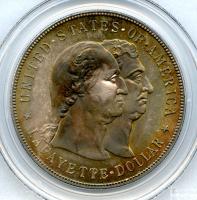LAFAYETTE SILVER S$1 PCGS MS65 CU IS $9,250.
LAFAYETTE SILVER S$1 PCGS MS65 CU IS $9,250.
Intended for display at the 1900 Paris Exposition, Paul Wayland Bartlett's equestrian statue of Lafayette is the subject of the reverse design for this type. In fact, the Lafayette Dollar - the only Silver Dollar in the classic U.S. Commemorative series - was issued to help defray the cost of completing this statue. The authorizing act is dated March 3, 1899, and it also seems likely that these coins were intended to commemorate the centennial of Washington's death in 1799. Indeed, the coins were struck in 1899 with the date 1900 signifying the year of the Paris Exposition. The reverse inscription ERECTED BY THE YOUTH OF THE UNITED STATES IN HONOR OF GEN LAFAYETTE PARIS 1900 also deserves explanation. Nationwide campaigns that ran for several months during 1899 prompted schoolchildren to donate pennies to help raise the $50,000 needed to fulfill the United States' pledge toward completing the moument.
Although the Lafayette Monument Commission lobbied for a press run of 100,000 coins, only 50,000 pieces (plus 26 extra examples for assay) were struck on December 14, 1899. The commission offered these coins for sale at $2 each, their standard passing to the American Trust & Savings Bank of Chicago in February, 1900. Very few examples sold, however, and the asking price dropped to just $1.10 per coin as early as 1903. Many of the unsold pieces were placed into circulation, while 14,000 others were returned to the Philadelphia Mint and stored in vaults until melted sometime prior to the end of World War II. The net mintage for distribution, therefore, is just 36,000 coins.
This is one Commemorative type that is just as likely to be encountered in worn condition as in Mint State. As stated above, many unsold examples were placed into circulation around the turn of the 20th century. We believe that additional coins found their way into commercial channels in later decades, probably during the Great Depression when their owners could no longer afford to retain them as collectibles. Even among Mint State survivors today's collectors and investors will find it difficult to locate high-quality, attractive representatives. Some coins are cleaned or otherwise impaired, while many possess numerous and/or sizeable abrasions that preclude a high numeric grade. A conditionally challenging issue, and one that is among the more important keys to the silver Commemorative series.
The classic silver Commemorative series commenced in 1892 with the first of three issues intended for sale at the World's Columbian Exposition. The final issues came in 1954 when the Philadelphia, Denver and San Francisco Mints struck Carver/Washington Half Dollars. After that year, the United States government would not produce any more Commemorative coins until 1982. Those Commems struck from 1892 through 1954 have long enjoyed a strong following among collectors and investors. Many issues are readily obtainable, at least through lower Mint State grades, which means that this is a great series for the beginning numismatist. As advanced specialists know, however, several types can be very challenging to locate in grades at, near or above the Gem threshold, while the low-mintage 1928 Hawaiian is elusive at all levels of preservation.







No comments:
Post a Comment